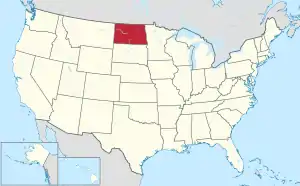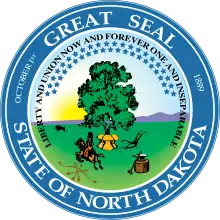Mercer County, North Dakota
Mercer County is a county in the U.S. state of North Dakota. As of the 2010 United States Census, the population was 8,424.[1] Its county seat is Stanton.[2]
Mercer County | |
|---|---|
 Cities of Mercer, left-to-right, up-to-down; Beulah, Golden Valley, Hazen, Pick City, Stanton, and Zap | |
 Location within the U.S. state of North Dakota | |
 North Dakota's location within the U.S. | |
| Coordinates: 47°18′N 101°49′W | |
| Country | |
| State | |
| Founded | January 14, 1875 (created) November 6, 1883 (organized) |
| Named for | W. H. H. Mercer |
| Seat | Stanton |
| Largest city | Beulah |
| Area | |
| • Total | 1,112 sq mi (2,880 km2) |
| • Land | 1,043 sq mi (2,700 km2) |
| • Water | 70 sq mi (200 km2) 6.3% |
| Population (2010) | |
| • Total | 8,424 |
| • Estimate (2019) | 8,187 |
| • Density | 7.6/sq mi (2.9/km2) |
| Time zone | UTC−6 (Central) |
| • Summer (DST) | UTC−5 (CDT) |
| Congressional district | At-large |
| Website | www |
History
The Dakota Territory legislature enacted an January 8, 1873 law to create a county named Mercer, whose boundaries would be identical to Pratt (a now-extinct county). This county did not come into existence, as the 1873 act was nullified on January 14, 1875 by the legislature. On that date the legislature created another Mercer County, from previously unorganized territory. The county was named for William Henry Harrison Mercer,[3] (1844–1901), a rancher who settled north of Bismarck in 1869. The unorganized county was not attached to another county for judicial or administrative purposes; this condition continued until November 6, 1883, when the county government was organized.
The county boundaries were altered in 1879, 1881, 1885, 1892, and 1901. Its boundaries have remained unchanged since 1901.[4][5]
Geography
The northern boundary of Mercer County is delineated by Lake Sakakawea, created in 1956 on the Missouri River. The county's eastern boundary is delineated by the river as it flows southeastward from the dam that created the lake. The county terrain consists of rolling hills, largely devoted to agriculture.[6] The terrain slopes to the north and east; its highest point is near the midpoint of its southern boundary, at 2,451' (747m) ASL.[7] The county has a total area of 1,112 square miles (2,880 km2), of which 1,043 square miles (2,700 km2) is land and 70 square miles (180 km2) (6.3%) is water.[8]
The southwestern corner counties of North Dakota (Adams, Billings, Bowman, Golden Valley, Grant, Hettinger, Slope, Stark) observe Mountain Time. The counties of McKenzie, Dunn, and Sioux counties are split, with their northern portions observing Central Time and the southern portions observing Mountain Time.
Major highways
Adjacent counties
- McLean County - north
- Oliver County - east
- Morton County - south
- Stark County - southwest (observes Mountain Time)
- Dunn County west (observes Mountain Time in southern portion)
Protected areas[6]
- Beaver Creek State Game Management Area
- Hazen Bay Recreation Area
- Knife River Indian Villages National Historic Site
- Lake Sakakawea State Park
Lake
Demographics
| Historical population | |||
|---|---|---|---|
| Census | Pop. | %± | |
| 1890 | 428 | — | |
| 1900 | 1,778 | 315.4% | |
| 1910 | 4,747 | 167.0% | |
| 1920 | 8,224 | 73.2% | |
| 1930 | 9,516 | 15.7% | |
| 1940 | 9,611 | 1.0% | |
| 1950 | 8,686 | −9.6% | |
| 1960 | 6,805 | −21.7% | |
| 1970 | 6,175 | −9.3% | |
| 1980 | 9,404 | 52.3% | |
| 1990 | 9,808 | 4.3% | |
| 2000 | 8,644 | −11.9% | |
| 2010 | 8,424 | −2.5% | |
| 2019 (est.) | 8,187 | [9] | −2.8% |
| US Decennial Census[10] 1790-1960[11] 1900-1990[12] 1990-2000[13] 2010-2019[1] | |||
2000 census
As of the 2000 United States Census, there were 8,644 people, 3,346 households, and 2,445 families in the county. The population density was 8.29/sqmi (3.20/km2). There were 4,402 housing units at an average density of 4.22/sqmi (1.63/km2). The racial makeup of the county was 96.04% White, 0.05% Black or African American, 2.00% Native American, 0.25% Asian, 0.38% Pacific Islander, 0.12% from other races, and 1.16% from two or more races. 0.37% of the population were Hispanic or Latino of any race. 68.8% were of German and 8.2% Norwegian ancestry.
There were 3,346 households, out of which 37.10% had children under the age of 18 living with them, 65.20% were married couples living together, 5.10% had a female householder with no husband present, and 26.90% were non-families. 24.80% of all households were made up of individuals, and 11.10% had someone living alone who was 65 years of age or older. The average household size was 2.55 and the average family size was 3.05.
The county population contained 29.10% under the age of 18, 4.20% from 18 to 24, 27.50% from 25 to 44, 24.90% from 45 to 64, and 14.30% who were 65 years of age or older. The median age was 40 years. For every 100 females there were 101.20 males. For every 100 females age 18 and over, there were 99.90 males.
The median income for a household in the county was $42,269, and the median income for a family was $51,983. Males had a median income of $47,969 versus $21,667 for females. The per capita income for the county was $18,256. About 5.50% of families and 7.50% of the population were below the poverty line, including 5.20% of those under age 18 and 20.90% of those age 65 or over.
2010 census
As of the 2010 United States Census, there were 8,424 people, 3,625 households, and 2,500 families in the county.[14] The population density was 8.08/sqmi (3.12/km2). There were 4,450 housing units at an average density of 4.27/sqmi (1.65/km2).[15] The racial makeup of the county was 95.6% white, 2.3% American Indian, 0.3% Asian, 0.2% black or African American, 0.1% Pacific islander, 0.4% from other races, and 1.1% from two or more races. Those of Hispanic or Latino origin made up 1.4% of the population.[14] In terms of ancestry, 64.7% were German, 21.5% were Norwegian, 6.6% were Russian, 6.2% were Irish, and 2.2% were American.[16]
Of the 3,625 households, 26.5% had children under the age of 18 living with them, 60.1% were married couples living together, 5.0% had a female householder with no husband present, 31.0% were non-families, and 27.3% of all households were made up of individuals. The average household size was 2.29 and the average family size was 2.76. The median age was 46.3 years.[14]
The median income for a household in the county was $60,191 and the median income for a family was $71,075. Males had a median income of $63,321 versus $32,294 for females. The per capita income for the county was $30,616. About 4.1% of families and 6.2% of the population were below the poverty line, including 7.2% of those under age 18 and 11.2% of those age 65 or over.[17]
Politics
Mercer County voters have traditionally voted Republican. In no national election since 1936 has the county selected the Democratic Party candidate (as of 2016).
| Year | Republican | Democratic | Third parties |
|---|---|---|---|
| 2020 | 82.5% 3,856 | 15.1% 704 | 2.5% 115 |
| 2016 | 80.3% 3,759 | 13.3% 621 | 6.5% 302 |
| 2012 | 70.8% 3,152 | 26.2% 1,166 | 3.1% 137 |
| 2008 | 63.4% 2,789 | 33.6% 1,476 | 3.0% 132 |
| 2004 | 71.2% 3,285 | 27.0% 1,245 | 1.9% 87 |
| 2000 | 68.6% 2,984 | 23.2% 1,011 | 8.2% 358 |
| 1996 | 48.3% 1,953 | 32.2% 1,300 | 19.5% 789 |
| 1992 | 45.3% 2,274 | 26.4% 1,323 | 28.3% 1,420 |
| 1988 | 61.5% 3,013 | 37.6% 1,843 | 0.9% 46 |
| 1984 | 67.2% 3,705 | 31.4% 1,729 | 1.4% 76 |
| 1980 | 68.0% 3,224 | 25.5% 1,209 | 6.5% 308 |
| 1976 | 59.8% 1,982 | 39.1% 1,298 | 1.1% 36 |
| 1972 | 74.3% 2,567 | 22.7% 784 | 3.0% 105 |
| 1968 | 69.4% 2,039 | 24.8% 730 | 5.8% 170 |
| 1964 | 54.0% 1,540 | 46.0% 1,310 | |
| 1960 | 73.9% 2,395 | 26.1% 844 | |
| 1956 | 79.2% 2,555 | 20.6% 666 | 0.2% 6 |
| 1952 | 85.0% 2,994 | 14.5% 512 | 0.5% 18 |
| 1948 | 75.3% 2,219 | 21.8% 643 | 2.9% 86 |
| 1944 | 84.7% 2,504 | 15.1% 445 | 0.2% 7 |
| 1940 | 85.4% 3,341 | 14.5% 567 | 0.2% 6 |
| 1936 | 31.6% 1,142 | 53.2% 1,924 | 15.3% 553 |
| 1932 | 16.0% 480 | 83.2% 2,491 | 0.7% 22 |
| 1928 | 37.5% 971 | 62.4% 1,619 | 0.1% 3 |
| 1924 | 25.0% 522 | 3.4% 70 | 71.6% 1,494 |
| 1920 | 87.3% 1,786 | 8.4% 172 | 4.4% 89 |
| 1916 | 64.2% 730 | 31.0% 353 | 4.8% 55 |
| 1912 | 20.0% 147 | 19.3% 142 | 60.8% 448 |
| 1908 | 81.1% 430 | 18.1% 96 | 0.8% 4 |
| 1904 | 93.3% 252 | 6.3% 17 | 0.4% 1 |
| 1900 | 86.8% 269 | 13.2% 41 |
References
- "State & County QuickFacts". US Census Bureau. Archived from the original on June 7, 2011. Retrieved November 1, 2013.
- "Find a County". National Association of Counties. Retrieved June 7, 2011.
- Gannett, Henry (1905). The Origin of Certain Place Names in the United States. U.S. Government Printing Office. p. 205.
- "County History". Official Portal for North Dakota State Government. Archived from the original on February 2, 2015. Retrieved May 4, 2011.
- Dakota Territory, South Dakota, and North Dakota: Individual County Chronologies/Mercer County ND (accessed February 26, 2019)
- Mercer County ND Google Maps (accessed February 26, 2019)
- ""Find an Altitude/Mercer County ND" Google Maps (accessed February 26, 2019)". Archived from the original on May 21, 2019. Retrieved February 27, 2019.
- "2010 Census Gazetteer Files". US Census Bureau. August 22, 2012. Archived from the original on January 29, 2015. Retrieved February 1, 2015.
- "Population and Housing Unit Estimates". Retrieved March 31, 2020.
- "US Decennial Census". US Census Bureau. Retrieved February 1, 2015.
- "Historical Census Browser". University of Virginia Library. Retrieved February 1, 2015.
- Forstall, Richard L., ed. (April 20, 1995). "Population of Counties by Decennial Census: 1900 to 1990". US Census Bureau. Retrieved February 1, 2015.
- "Census 2000 PHC-T-4. Ranking Tables for Counties: 1990 and 2000" (PDF). US Census Bureau. April 2, 2001. Retrieved February 1, 2015.
- "Profile of General Population and Housing Characteristics: 2010 Demographic Profile Data". US Census Bureau. Archived from the original on February 13, 2020. Retrieved March 14, 2016.
- "Population, Housing Units, Area, and Density: 2010 - County". US Census Bureau. Archived from the original on February 13, 2020. Retrieved March 14, 2016.
- "Selected Social Characteristics in the US – 2006-2010 American Community Survey 5-Year Estimates". US Census Bureau. Archived from the original on February 13, 2020. Retrieved March 14, 2016.
- "Selected Economic Characteristics – 2006-2010 American Community Survey 5-Year Estimates". US Census Bureau. Archived from the original on February 13, 2020. Retrieved March 14, 2016.
- Leip, David. "Atlas of US Presidential Elections". uselectionatlas.org. Retrieved April 12, 2018.
